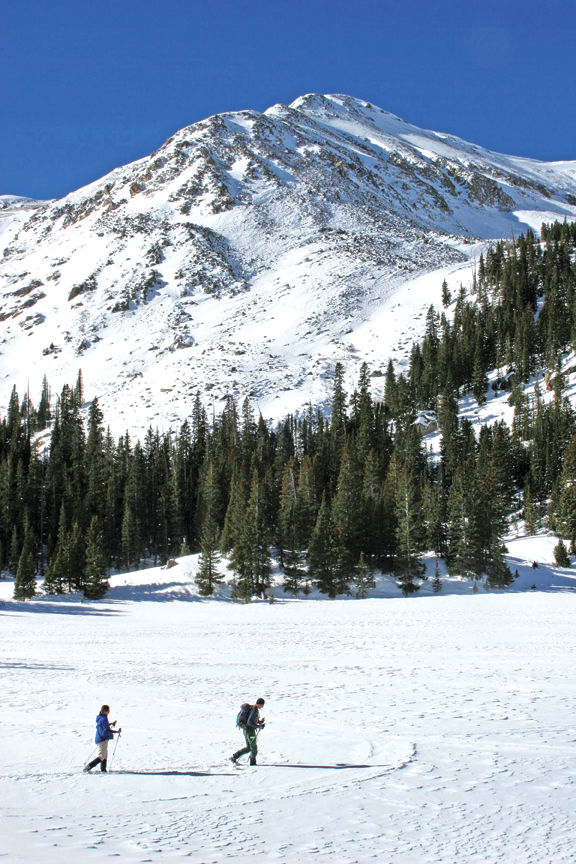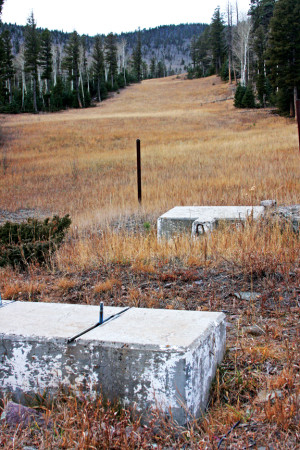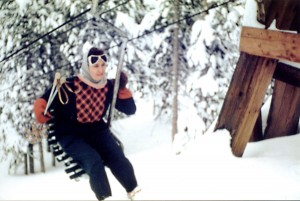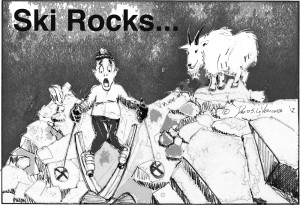By Nate Porter
As the seasons change and the winter solstice approaches, it’s time to turn our attention from warmer weather activities to other things. Of course, in Central Colorado we are lucky enough to enjoy a climate that allows many different activities year-round. Hiking and biking here can be great in the winter, but how about mixing it up a little with some cross-country skiing? Why cross country, also known as Nordic, skiing? Well, there are many reasons to get out and experience the environment on skinny skis.
Foremost are the physical and mental health benefits. Nordic skiing is great for the whole body. The legs and lungs get a great workout as does the upper body. Humans were designed to move over the earth in an upright, bipedal manner. Walking allows us to feel grounded and connected to the earth in the most basic way. Nordic skiing is simply the winter version of this. It’s good for working different muscles, easy on the back, and encourages breathing in a deep, rhythmic manner.

We all know good physical health is important for good mental health. Studies show that even a small amount of outdoor exercise can improve a person’s attitude and help lower stress. Aside from the health benefits, Nordic skiing is fun! There’s something about being outdoors in the winter on a clear, cold, sunny day. The crisp, cold air feels great in the lungs. A blanket of white snow makes the landscape appear fresh and new, even on familiar terrain. Skiing can be a whole new way to enjoy your favorite summer trail. One thing that skiing offers that hiking doesn’t is glide. Once you get into a good kick and glide rhythm, it’s almost as if you’re skimming effortlessly along the surface of the earth.
Nordic skiing is relatively cheap and easy to get into. A basic equipment package sells for as little as $325 new, and used gear can be had for less. Be sure to get a good-fitting boot. Unhappy feet mean an unhappy skier. Boots should fit like a good hiking boot – a little room in front of the toe, a snug, glove-like fit through the mid-foot and ankle, with as little heel slop as possible. Socks should be wool, synthetic, or a blend – but no cotton. Wool and synthetics wick perspiration away from the foot, keeping it warmer and drier. Cotton absorbs moisture, making feet colder and more prone to blistering. If you’re looking at used gear, be sure the boots and bindings are compatible. There are many boot/binding systems, not all of which work together. A knowledgeable friend or your local ski shop can help with this.
Skis are sized by two methods, depending on the design. Older, narrower skis were sized longer to provide good grip, glide and flotation. This was based mostly on skier height. Newer designs are sized more by total weight of the skier and gear, and are usually sized shorter than older skis. All Nordic skis have what is called “camber.” This is the arch of the ski when put on a flat surface or when skis are held together base to base. Camber is what allows the ski to alternately grip and glide when weighted and unweighted. Skis grip the snow by either “fish scales,” also known as a wax-less base, or with kick wax.
You may have heard that if you can walk, you can cross-country ski, which is mostly true, but there is a little technique involved. The basic progression has the skier weight one ski, pressing the scales or wax into the snow for grip, while striding forward and gliding on the unweighted ski. This process is repeated as the skier shifts weight to the gliding ski, compressing the camber into the snow, now gliding off the first ski. It’s like walking, with an emphasis on weighting the ski as you step forward.
Waxless skis are more common these days, mostly because they are more convenient. In the days before waxless skis, skiers used different kick waxes to grip the snow. Kick waxes come in different hardness for different temperatures of snow – harder for colder snow, softer for warmer snow. Kick wax works by allowing snow crystals to penetrate the wax, creating grip. Waxing is a little more involved than going waxless, but it’s not hard to do. Once you learn the right waxes for the area and conditions you ski in, you will rarely have to do anything different. The benefits of waxless are convenience and reasonable performance in all conditions, but glide will suffer a little due to the friction of the scales. Waxing will give better glide and provide plenty of grip, as long as the right wax is used. Warm snow, or old, refrozen snow, can be tricky to wax for. Waxless skis grip well in snow approaching 32 degrees Fahrenheit, without having to resort to very soft kick waxes known as klister, which is like toothpaste and difficult to use.
Kick waxing can be intimidating for a beginner, so consider waxless for your first ski, and consider wax-able after you’ve got some experience. Both waxed and no-wax skis do require some maintenance. Even a waxless ski should have some kind of glide wax applied, just as one would for an Alpine ski. The tips and tails of these skis can be hot waxed, but not the scales. Use a liquid or paste glide wax on the scales, or the whole ski base. This keeps them gliding and seals the base, preventing icing.
Poles are the least important part of the package, but make sure to get the right length. They should be sized so that the grip fits snugly under the arm with the tip on the ground, more or less. If you use trekking poles in the summer, they can make good ski poles, albeit a bit of an overkill for Nordic skiing.
Now that you know something about equipment, where do you go? Well, that depends on conditions and what you want to do. It can be as simple as the nearest park, field, or golf course. Many of the trails and forest roads we hike, bike and drive on can be good skiing. Depending on the season and storm tracks, sometimes there will be good skiing in the most unlikely places – watch the weather and use your imagination! If you plan on skiing steeper terrain, consider a metal-edged ski for more control, and skins for climbing. Here are some suggestions for easy to advanced ski tours:
Other Resources:
Book: Skinny Skis and Snowshoes by Nate Porter and Nathan Ward
Nate Porter lives in Salida with his wife, Diana, and daughter, Madelyn. He’s got all ten fingers and toes crossed that this will be a better winter than last!





